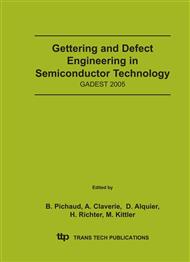p.401
p.407
p.413
p.419
p.425
p.433
p.439
p.445
p.451
Defect Interaction Mechanisms between Antimony and Indium in Silicon
Abstract:
Heavy species such as Sb, In, and Ge are required to meet the challenges of future dopant engineering in planar CMOS technology. An understanding of the interactions of these species with each other and with conventional dopants is urgently required in order to meet aggressive criteria for junction control in sub-sixty nanometer technology nodes. In the current work, the interactions between Sb and In have been explored as a function of ion implantation dose and annealing treatment. The data shows strong interaction between the two species which prevents the dissolution of an as-implanted In profile even after high temperature anneal. The nature of the interaction is probed with fundamental calculations using plane wave density functional theory. A strong binding for an Sb-In-vacancy complex is revealed. Band structure analysis indicates that this defect complex introduces several unoccupied states primarily in the upper half of the bandgap. The two species contribute with nearly equal magnitude to the top valence band.
Info:
Periodical:
Pages:
425-432
Citation:
Online since:
December 2005
Authors:
Keywords:
Price:
Сopyright:
© 2005 Trans Tech Publications Ltd. All Rights Reserved
Share:
Citation:


